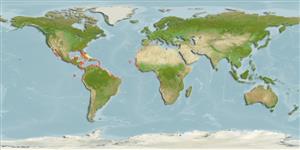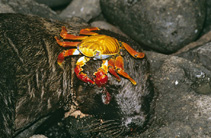Grapsus grapsus (Linnaeus, 1758)
Lightfoot crab| Native range | All suitable habitat | Point map | Year 2050 |

|
| This map was computer-generated and has not yet been reviewed. |
| Grapsus grapsus AquaMaps Data sources: GBIF OBIS |
Classification / Names Common names | Synonyms | CoL | ITIS | WoRMS
Malacostraca | Decapoda | Grapsidae
Environment: milieu / climate zone / depth range / distribution range Ecology
Benthic; depth range 0 - 5 m (Ref. 106471). Tropical; 40°N - 35°S, 126°W - 28°E
Distribution Countries | FAO areas | Ecosystems | Occurrences | Introductions
Indo-Pacific and Atlantic: from Baja California (Mexico) to Chile, including Clipperton Island, Galapagos Islands and other Pacific oceanic islands; from south Florida to central America, West Indies, to Colombia, Venezuela and Brazil, to western Africa and Portugal, including Azores, Cape Verde, Sao Tome and Principe, Ascension and Saint Helena. Subtropical and tropical.
Length at first maturity / Size / Weight / Age
Maturity: Lm ?, range 3 - 3.38 cm Max length : 7.7 cm CL male/unsexed; (Ref. 435)
Maximum carapace width: 8.7 cm. Inhabits rocks near water line and is very active on land, taking refuge in the sea when threatened (Ref. 435). Supralittoral to intertidal (Ref. 104055). Abundant in splash zones (Ref. 105697). On rubbles (Ref. 106471). Feeds on cirripedes, mytilids, and porcelain crabs; occasionally acts as a scavenger. Also preys upon sea turtles and on the lookout for marine birds nest (Ref. 106452). Herbivorous (Ref. 106455).
Life cycle and mating behavior Maturity | Reproduction | Spawning | Eggs | Fecundity | Larvae
Members of the order Decapoda are mostly gonochoric. Mating behavior: Precopulatory courtship ritual is common (through olfactory and tactile cues); usually indirect sperm transfer.
Main reference
References | Coordinator | Collaborators
Fischer, W., G. Bianchi and W.B. Scott (eds.). 1981. (Ref. 435)
IUCN Red List Status (Ref. 130435)
CITES status (Ref. 108899)
Not Evaluated
CMS (Ref. 116361)
Not Evaluated
Threat to humans
Human uses
Fisheries: subsistence fisheries
| FishSource | Sea Around Us
Tools
More information
Internet sources
BHL | BOLD Systems | CISTI | DiscoverLife | FAO(Publication : search) | Fishipedia | GenBank (genome, nucleotide) | GloBI | Gomexsi | Google Books | Google Scholar | Google | PubMed | Tree of Life | Wikipedia (Go, Search) | Zoological Record
Estimates based on models
Preferred temperature
(Ref. 115969): 22.2 - 28.3, mean 27.1 (based on 1189 cells).
Price category
(Ref. 80766):
Unknown.



